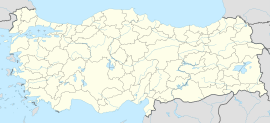Karalar (Arabic: عربان, Kurdish: Eraban;[2] Syriac: ܥܪܒܐܢ, romanized: ʿArban)[3][a] is a town (belde) in the İdil District of Şırnak Province in Turkey.[5] The settlement is populated by Kurds of the Domanan tribe and had a population of 4,065 in 2021.[1][2] It is located in the historic region of Tur Abdin.[6]
Karalar | |
|---|---|
| Coordinates: 37°17′56″N 41°40′37″E / 37.299°N 41.677°E | |
| Country | Turkey |
| Province | Şırnak |
| District | İdil |
| Population (2021)[1] | 4,065 |
| Time zone | UTC+3 (TRT) |
History
editʿArban (today called Karalar) was historically inhabited by Syriac Orthodox Assyrians.[7] There was a church of the Virgin and Mar Barsoum.[8] The monk-priest Yeshu’, son of the priest Barṣoum of Arban, was a renowned calligrapher (fl. 1298).[9] The village was attacked by Bakhti Kurds in 1453 alongside the neighbouring villages of Beth Sbirino, Bēth Isḥaq, and Midun, as per the account of the priest Addai of Basibrina in c. 1500 appended to the Chronography of Bar Hebraeus.[10] Bakhti Kurds attacked ʿArban, as well as the villages of Bēth Isḥaq and Midun, again in 1457, resulting in the death of the priests Behnam and Addai, the deacon Abu Nasr, and 40 men whilst the women and children were taken captive.[11]
In 1748, the episcopal residence of the Church of the Virgin and Mar Barsoum was renovated by Basil Denha Baltaji, the Maphrian of Tur Abdin, at which time the village was inhabited by 14 Syriac Orthodox families.[12] ʿArban was later visited by Aphrem Barsoum in 1911 who noted only two Syriac Orthodox families and roughly 40 Muslim families resided there whilst the church lay in ruins.[12] In 1914, the village was inhabited by 100 Assyrians, according to the list presented to the Paris Peace Conference by the Assyro-Chaldean delegation.[13] There were 100 Assyrian families in 1915.[14]
References
editNotes
Citations
- ^ a b "31 ARALIK 2021 TARİHLİ ADRESE DAYALI NÜFUS KAYIT SİSTEMİ (ADNKS) SONUÇLARI" (XLS). TÜİK (in Turkish). Retrieved 16 December 2022.
- ^ a b Baz (2016), p. 148.
- ^ Carlson, Thomas A. (9 December 2016). "ʿArban - ܥܪܒܐܢ". The Syriac Gazetteer. Retrieved 27 May 2023.
- ^ Jongerden & Verheij (2012), p. 321; Keser-Kayaalp (2022), p. 17.
- ^ "Türkiye Mülki İdare Bölümleri Envanteri". T.C. İçişleri Bakanlığı (in Turkish). Retrieved 19 December 2022.
- ^ Barsoum (2003), p. 559.
- ^ Jongerden & Verheij (2012), p. 321.
- ^ Barsoum (2008), p. 18; Barsoum (2009), p. 54.
- ^ Barsoum (2003), p. 545; Barsoum (2008), p. 110.
- ^ Barsoum (2008), p. 70.
- ^ Barsoum (2008), p. 71.
- ^ a b Barsoum (2009), p. 54.
- ^ Gaunt (2006), p. 427.
- ^ Dinno (2017), p. 383.
Bibliography
edit- Barsoum, Aphrem (2003). The Scattered Pearls: A History of Syriac Literature and Sciences. Translated by Matti Moosa (2nd ed.). Gorgias Press. Retrieved 14 July 2020.
- Barsoum, Aphrem (2008). The History of Tur Abdin. Translated by Matti Moosa. Gorgias Press. Retrieved 1 April 2021.
- Barsoum, Aphrem (2009). History of the Syriac Dioceses. Vol. 1. Translated by Matti Moosa. Gorgias Press. Retrieved 26 June 2021.
- Baz, Ibrahim (2016). Şırnak aşiretleri ve kültürü (in Turkish). ISBN 9786058849631.
- Dinno, Khalid S. (2017). The Syrian Orthodox Christians in the Late Ottoman Period and Beyond: Crisis then Revival. Gorgias Press. Retrieved 26 November 2024.
- Gaunt, David (2006). Massacres, Resistance, Protectors: Muslim-Christian Relations in Eastern Anatolia during World War I. Gorgias Press. Retrieved 21 May 2023.
- Jongerden, Joost; Verheij, Jelle, eds. (2012). Social Relations in Ottoman Diyarbekir, 1870-1915. Brill. Retrieved 20 November 2024.
- Keser-Kayaalp, Elif, ed. (January 2022). Syriac Architectural Heritage at Risk in TurʿAbdin (PDF). Retrieved 8 November 2024.
